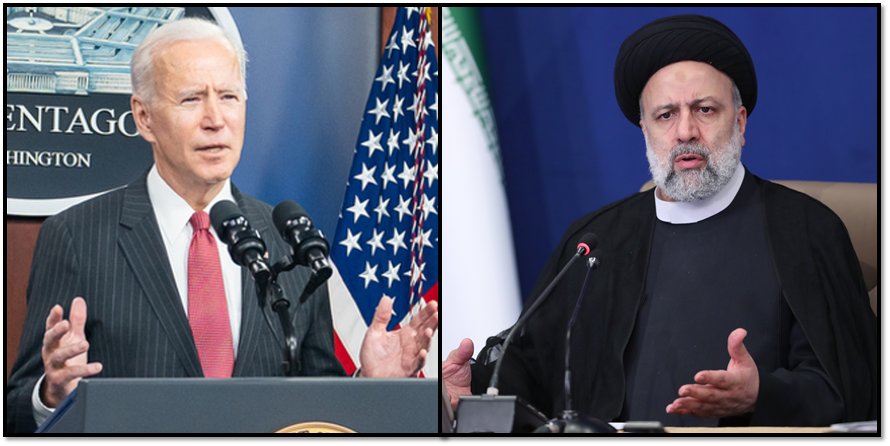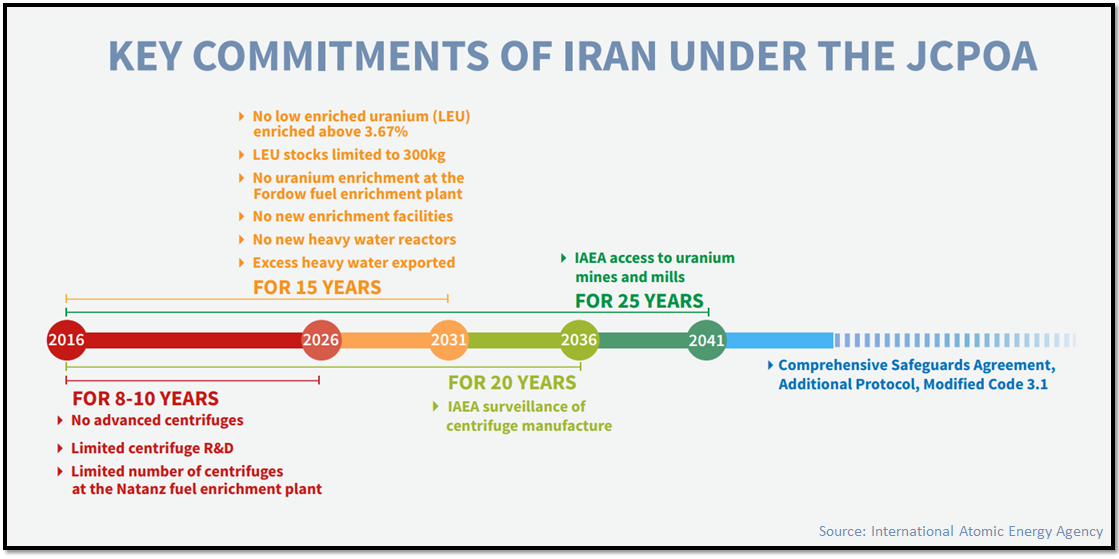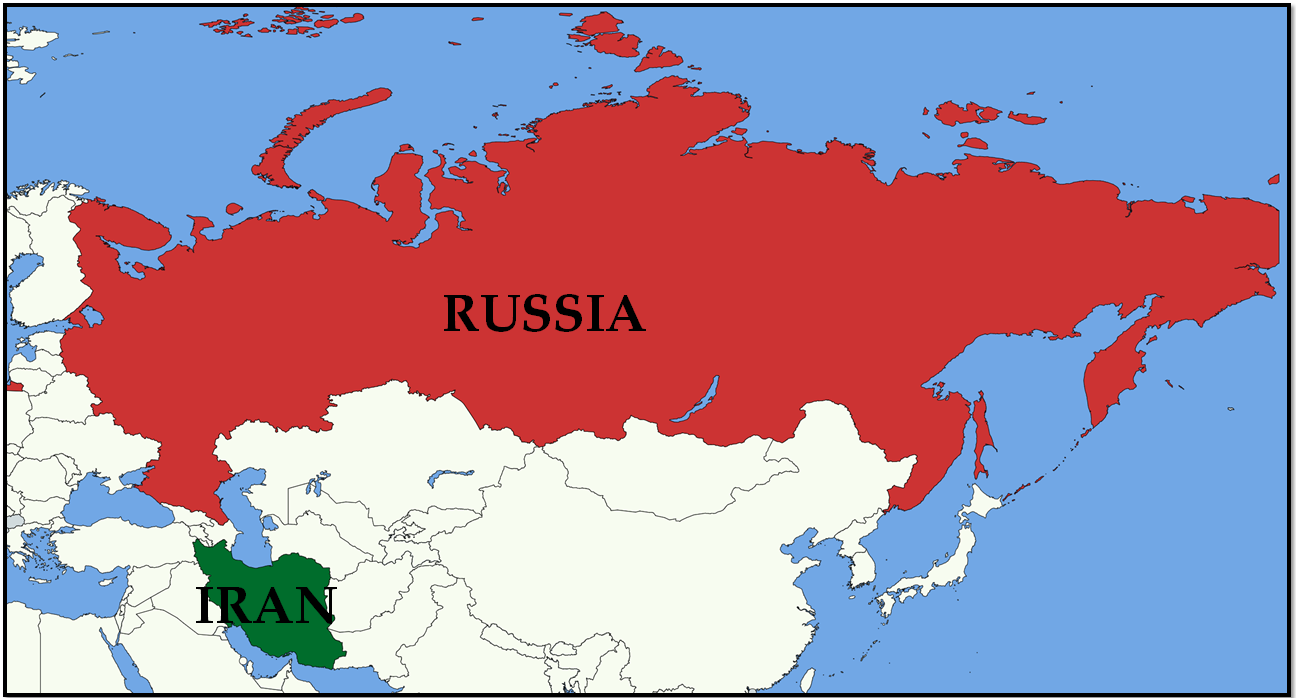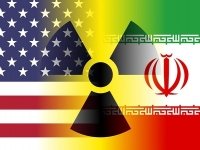Common Grounds
Our Friday News Analysis | How Do You Love Your Enemies? Have None! (Part 6)
Can we Create a Better World?
The Hague, 26 May 2023 | If you know of any story that is decisive, tell the world. We're still searching.

Editor’s Note |
Suppose we continue to focus on our many fears—our fear of terrorists, our fear of socialism, our fear of no longer being the strongest and wealthiest nation on earth, and many more little fears—to justify spending more time, money, and energy to build more devastating weapons.
In that case, our planet will have little chance of surviving past our lifetimes.
EXPLAINER | CAN THE IRAN DEAL BE RESUSCITATED?
Is restoring the nuclear deal with Iran—brokered in 2015 and abandoned by the United States in 2018—still possible after almost two years of stalled diplomacy?
By Kelsey Davenport
The Iran Primer
January 11, 2023
Kelsey Davenport is the Director for Nonproliferation Policy at the Arms Control Association.
But first, how’s life in Iran? Here’s a note from SIR, my Source in Iran:
Hi Abraham
How are you and the family?
The people of Iran are in dire straits.
The mullahs have made life unbearable, with high inflation bad economy intended to make people poor, so they worry about making a living rather than demanding their rights to everyday life.
Everything is in a shamble, economy, food, culture, environment, air pollution, art, music, and people getting a heavy dose of religion and superstitions. The mullahs are cruel and kill anyone and everyone without remorse, especially the protesters saying and opposing their actions.
They are wasting the country’s treasures on useless terroristic ideology and pocketing anything that remains in billions to their cronies and their families. People are not benefiting from any of it. Hijab is a brutal way to control people.
Iran is occupied by the mullahs and their cronies, who represent 12 percent of the population. The mullahs are not genuinely Iranian. They are bastard Arabs (Arabs call them that). The government in Iran is made up of an extraordinarily uneducated and brainwashed fanatical sect. The president has an eighth-grade education. The rest are as ignorant.
My Source in Iran continues:
Persians were culturally rich with beliefs such as not stealing, trusting one another, helping others, saying the right things, doing the right things, being polite, respecting others and all living beings, and so much more, real pure, honest, and straightforward. I’ve witnessed it growing up among people of all ethnic and backgrounds.
The so-called religious mullahs have ruined everything, with nothing left of morals and rich culture. They have practically turned the country into whore house with mullahs as gatekeepers. Bribes and stealing are going through the roof. Yet, they cut off the hands of needy people for a piece of bread while they steal billions.
They hang people after torturing them to get forced confessions. Intellectuals like writers, journalists, poets, movie makers, etc., are killed under false accusations like drug traffickers. They poison-gassed over a thousand girls in high schools in Iran over five months because they were demonstrating against the mullahs for freedom and their corruption. Prisons are like universities full of intelligent people. Criminals freely move around in society. The intellectuals are in jail.
We are under occupation,
EXPLAINER | CAN THE IRAN DEAL BE RESUSCITATED? (Continues)

President Joe Biden and President Ebrahim Raisi
From a technical perspective, restoring the agreement, known formally as the Joint Comprehensive Plan of Action (JCPOA), is possible. Politically, however, it will be challenging.
On the technical side, many of Iran’s violations of the nuclear deal were reversible as of early 2023. Iran could immediately halt uranium enrichment to levels above the JCPOA cap of 3.67 percent. It has enriched uranium to 60 percent – close to 90 percent, which is considered weapons-grade. Iran could blend down its enriched uranium to natural levels or ship out the excess stockpiles to another country. Additionally, it could store, dismantle or destroy centrifuges installed and operating in excess of JCPOA limits. Iran would need to halt enrichment at the Fordo facility, buried under the mountains near Qom. It would also need to remove any uranium and advanced IR-6 centrifuges from the site. Iran has, however, gained knowledge from enrichment to 60 percent and its operation of advanced centrifuges that cannot be reversed.
The U.N. nuclear watchdog, the International Atomic Energy Agency (IAEA), could reestablish the intrusive monitoring and verification provisions required by the deal. The agency would, however, face difficulties re-establishing the baseline knowledge of Iran’s program. It would need to bridge the gap in monitoring and access to certain sites that support the nuclear program but do not house nuclear materials, such as enriched uranium. Inspectors have not had access to these sites since February 2021. In June 2022, Iran disconnected the cameras intended to provide the IAEA with recordings of activities at these locations if the JCPOA was restored. Without an accurate baseline, verifying certain JCPOA limits could be challenging for the IAEA.
The primary challenge was on the political side as of early 2023. The world’s six major powers – Britain, China, France, Germany, Russia and the United States – were very close to reaching an agreement with Iran in August 2022. But the talks stalled after Iranian negotiators made unrealistic demands beyond the scope of the JCPOA. They stipulated that Iran would agree to a deal only if the U.N. nuclear watchdog closed an investigation into traces of uranium found at three undeclared sites within a specified period. They also demanded that the IAEA never again investigate Iran’s past nuclear activities.
But the United States and its partners cannot dictate how the IAEA applies safeguards. Pressuring the U.N. agency could undermine its credibility and independence, which are crucial for its sensitive work monitoring and verifying the peaceful nature of nuclear programs worldwide. Iran’s insistence on tying this extraneous issue to the JCPOA raised questions about its intentions to return to the deal.
In the fall of 2022, the U.S. and European focus shifted to Iran’s brutal crackdown on domestic protests and its provision of drones to Russia for the war in Ukraine. Iran was prohibited from selling certain types of drones, missiles, and related technology under U.N. Security Council Resolution 2231, which endorsed the JCPOA, until October 2023. The Biden administration felt pressure not to engage with Tehran while the protests continued, narrowing the political space for reviving the deal.
The JCPOA included expiration dates, or “sunset” clauses, for certain restrictions on Iran. Which sunset dates have already passed or are coming up? Are there any remaining nonproliferation benefits?
Restoration of the JCPOA’s limits and intrusive monitoring provisions would provide significant nonproliferation benefits. Iran’s breakout time – the time needed to produce enough fuel for one nuclear bomb – would increase from less than one week to somewhere in the four- to six-month range. That extended timeline would give the international community significantly more time to act if a breakout was detected.
Reinstating the monitoring mechanisms – the most intrusive ever negotiated – would provide significantly more insight into the nuclear program. This would provide greater assurance that a breakout would be detected more quickly and protect against Iran diverting materials for covert activities.
Some of the JCPOA’s most crucial nonproliferation benefits are permanent. Iran must implement the Additional Protocol, which expands IAEA access to facilities and information, in perpetuity. The more intrusive monitoring and verification requirements are long-term guardrails against a nuclear-armed Iran. The JCPOA also prohibits Iran from undertaking certain activities relevant to building the explosive package for a nuclear weapon in perpetuity.

Other provisions from the JCPOA and U.N. Security Council Resolution 2231 expire over time. In October 2020, the U.N. conventional arms embargo on Iran was lifted. It was the first set of restrictions to expire, five years after the JCPOA was adopted. More concerning are restrictions due to expire in October 2023. U.N. Security Council Resolution 2231 barred Iran from importing or exporting certain types of missiles and drones without Security Council approval. In 2022, Iran already provided Russia with hundreds of drones for use in the war on Ukraine. It may plan to transfer missiles as well, according to the White House. The United States and its European partners have alleged violations of Resolution 2231. But the October 2023 “sunset” provision will make the matter moot.
Some of the more significant limitations on Iran's uranium enrichment program will phase out in 2031, 15 years after the deal was implemented. They include the cap on the enriched uranium stockpile and the limits on enrichment to 3.67 percent. When these limits expire, Iran’s breakout time could shorten again, potentially down to zero. But absent the JCPOA, Iran was already at near-zero breakout in early 2023. From a nonproliferation perspective, the eight-year delay is preferable.
What are the alternatives to the JCPOA?
Read more: Explainer | Can the Iran Deal Be Resuscitated?
What is the Side of the Story that is Not Yet Decisive? Edited by Abraham A. van Kempen.
Opinion
Moving from the house of fear to the home of love is necessary not just for each of us individually but for the survival of the human family.
Suppose we continue to focus on our many fears—our fear of terrorists, our fear of socialism, our fear of no longer being the strongest and wealthiest nation on earth, and many more little fears—to justify spending more time, money, and energy to build more devastating weapons?
In that case, our planet will have little chance of surviving past our lifetimes.
We must move out of the place of death wishes and death threats and search as nations for ways toward international reconciliation, cooperation, and care.
We need academies of peace, ministries of peace, and peacekeeping forces.
We need educational, church, market, and entertainment reform that makes peace its primary concern.
We need a new economic order beyond capitalism and socialism that makes peace and justice its entire goal.
We need to believe as nations that a new international order is possible and that the rivalries between countries or blocs are as outdated as the medieval rivalries between cities.
Is a mass movement possible leading from fear to love, from death to life, from stagnation to rebirth, from living as rivals to living as people of God who belong to one human family?
Many will consider this grand vision naive. Do we have a choice?
Whole nations, not just individuals, are called to leave the house of fear, where suspicion, hatred, and war rule, and enter the place of love, where reconciliation, healing, and peace can reign.
The great spiritual leaders, from St. Benedict to St. Catherine of Siena to Martin Luther King Jr. to Thomas Merton, have all grasped this truth. They offer a glimpse of a new order born out of the ruin of the old.
The world is waiting for new saints—prophetic women and men who are so deeply rooted in the love of God that they are free to envision and create a new world where justice reigns, war is no more, where the old order of things has passed away.
In that house, we can slowly release our fear and learn to trust.
In that house, we can find freedom, community, and joy.
Peacemaking is possible when we live in the house of love.
Justice can be practiced when we live in the house of love.
Ministry is practical when we live in the house of love.
There we can be, and move, and trust and love in freedom and without fear.
Adapted from: Nouwen, Henri J. M., Spiritual Formation (pp. 82-83). HarperCollins. Kindle Edition.
Gravitas: Iran Unveils New Kheibar Ballistic Missile

Click here to view video (2 minutes, 56 seconds)
Iran has unveiled its new Kheibar ballistic missile.
Israel has warned of a possible war with Iran.
Is the world ready for another war?
IRANIAN INSIDER AND BRITISH SPY: HOW A DOUBLE LIFE ENDED ON THE GALLOWS
1 May 2023
New York Times
By Farnaz Fassihi and Ronen Bergman
Western intelligence officials said Iran executed a former deputy defense minister in January 2023 who provided Britain with valuable intelligence on Iranian nuclear and military programs over a decade.

Alireza Akbari during an interview in Tehran. Iran announced in January that Mr. Akbari had been executed on espionage charges for Britain. Credit: Khabar Online News Agency
Read more: Iranian Insider and British Spy: How a Double Life Ended on the Gallows?
United States Institute of Peace
The Iran Primer
17 May 2023
Our special edition on Iran and Russia includes: A Tehran political scientist analyzes the strategic shift to Moscow; the seven phases of developing military ties; an explainer on the new North-South Corridor; the four phases of gyrating trade; and the news digest.

Explainer: Iran’s Strategic Pivot to Russia
For decades Iran and Russia have collaborated on trade, energy, arms, and nuclear projects. Tehran has often been frustrated with Moscow’s slow implementation of agreements. But the two had grown much closer since 2022, when Iran started providing military support to Russia for the war in Ukraine. Trade increased as they helped each other skirt Western sanctions.
Iran & Russia: Burgeoning Military Ties
Military cooperation between Iran and Russia has gyrated from virtually nothing after the 1979 revolution to a strategic partnership, bolstered by necessary arms transfers, by 2023, and according to data from the Stockholm International Peace Research Institute, Moscow accounted for about a third of Tehran’s arms imports during the four decades after the revolution. According to John Kirby of the National Security Council, the two countries had forged a “full-scale defense partnership” by mid-2023.
Iran & Russia: New Land & Sea Networks
Since 2002, Iran, Russia, and India have worked intermittently on a new transportation system by rail, road, and sea—running 4,500 miles through at least six Eurasian countries and benefitting seven others—that could be a game-changer for global trade. The joint project aims to cut travel costs by up to a third and shipping time by nearly a half.
Iran & Russia: Gyrating Trade Grows
Trade between Iran and Russia fluctuated wildly in the three decades after the Soviet Union collapsed in 1991. It plummeted by 65 percent between 2010 and 2015 during UN sanctions on Iran, then nearly quadrupled by 2022 after international sanctions were lifted, a new trade route opened, and a budding military alliance deepened.
US Report on Religious Freedom in Iran
On May 15, the State Department released its annual report on religious freedom. Secretary of State Antony Blinken condemned the Iranian government for the crackdown on protesters. “People across Iran, led by young women, continue peaceful protests demanding their human rights, including freedom of religion, galvanized by the killing of Masa Amini, who was arrested by the so-called morality police because her hijab did not fully cover her hair.”
News Digest: Week of May 15
During the week of May 15, the United States charged a Chinese national for attempting to provide materials for Iran’s ballistic missile program. The White House announced that Russia sought to purchase more Iranian drones against Ukraine, and Azerbaijan arrested at least nine people accused of plotting assassinations on behalf of Iran.
A RACE FOR POWER IN THE MIDDLE EAST

Click Here to Watch Video (1 hour, 12 minutes)
Carnegie Endowment for International Peace
16 May, 2023
“Today, the United States reduces its presence in the Middle East and North Africa—with bipartisan support—following failed wars in Afghanistan and Iraq and increased indigenous energy wealth. Meanwhile, China and Russia have begun independently filling the void the United States leaves behind with military, diplomatic, and economic engagement.
Longtime US regional adversaries, such as Iran and Syria, have welcomed China and Russia’s growing regional presence as a counterweight to the United States. At the same time, longtime US partners, including Saudi Arabia, Egypt, Israel, and Jordan, have clarified that they do not want to choose sides between the great powers.
In the context of the emerging competition between the United States, Russia, and China on the global stage, how should the United States adapt its policy in the MENA region?”
_______________________
Related Articles Recently Posted on www.buildingthebridgefoundation.com:
Our Friday News Analysis | 'How Do You Love Your Enemies? Have None! (Part 5),' 19 May 2023.
Our Wednesday News Analysis | 'Nakba denial is at the heart of pro-Israel lobbying,' 24 May 2023.
The Evangelical Pope| 'A Symphony Among Jews, Christians, and Muslims,' 22 May 2023.
_________________________
The views expressed are solely those of the author and may or may not reflect those of the Building the Bridge Foundation, The Hague.
LATEST OPEN LETTERS
-
21-07Freedom
-
20-03Stand up to Trump
-
18-02Average Americans Response
-
23-12Tens of thousands of dead children.......this must stop
-
05-06A Call to Action: Uniting for a Lasting Peace in the Holy Land
-
28-05Concerned world citizen
-
13-02World Peace
-
05-12My scream to the world
-
16-11To Syria and Bashar al-Assad
-
16-11To Palestine
VIRTUAL POST OFFICE
PETITIONS
LINKS
DONATION
Latest Blog Articles
-
23-12Why Palestinians face the same fate, weapons or not
-
23-12Western elites fear a ‘globalised intifada’ because they are its targets, not Jews
-
23-12A smaller cage: Israel’s ‘two-state solution’ on Gaza’s ruins
-
22-12The Evangelical Pope | A Humane Future Before God
-
17-12Our Wednesday News Analysis | Gaza and the unravelling of a world order built on power
-
16-12Gaza and the unravelling of a world order built on power
-
16-12US plan in Gaza: forced ghettoisation, annexation, mass detention, resource plunder
-
16-12Von der Leyen and Blair still want to boss Palestinians around
-
15-12The Evangelical Pope | The Universal Value of Life
-
11-12Our Friday News Analysis | What the World Reads Now!
-
10-12Our Wednesday News Analysis | A story of a 1930s uprising against British colonialism is key to understanding Gaza today
Latest Comments
 One of the most important and illuminating articles that I …
One of the most important and illuminating articles that I …
Comment by Benjamin Inbaraj And what's wrong here?
After all, there is the homeland …
And what's wrong here?
After all, there is the homeland …
Comment by Isac Boian Does this reinforce or deny my argument that Israel is …
Does this reinforce or deny my argument that Israel is …
Comment by Edward Campbell Many 'say' they support the Palestinian cause but do little …
Many 'say' they support the Palestinian cause but do little …
Comment by Philip McFedries The UN is strangled by the "war for profit" cabal …
The UN is strangled by the "war for profit" cabal …
Comment by Philip McFedries I can't read the printing on the map.
I can't read the printing on the map.
Comment by Philip McFedries Good news!
Good news!
Comment by Philip McFedries

COMMENTS
This article has 0 comments at this time. We invoke you to participate the discussion and leave your comment below. Share your opinion and let the world know.